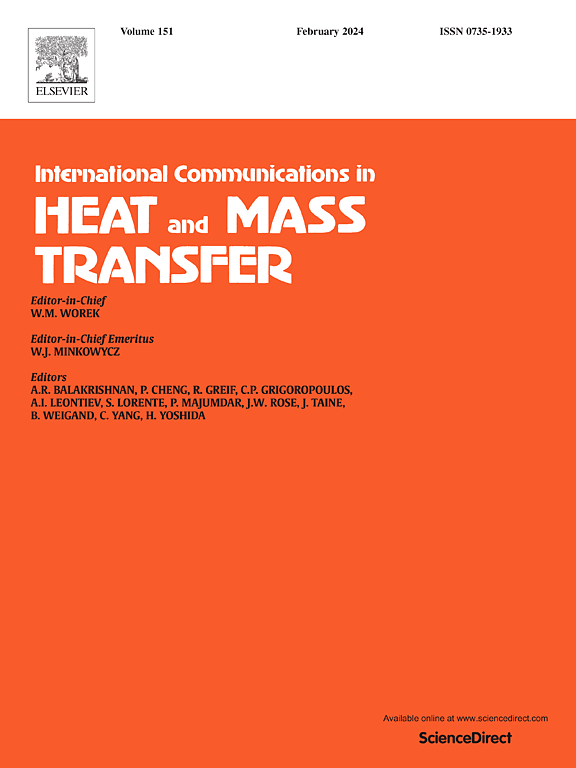不同围压和温度条件下页岩裂缝气体渗流特性演化
IF 6.4
2区 工程技术
Q1 MECHANICS
International Communications in Heat and Mass Transfer
Pub Date : 2025-05-16
DOI:10.1016/j.icheatmasstransfer.2025.109039
引用次数: 0
摘要
研究了温度和围压对岩石裂隙渗流特性的影响。通过理论分析和数值模拟相结合,提出并验证了一种新的耦合模型,该模型综合了围压、温度和裂缝中气体渗流的相互影响。这些因素的耦合特性表现为协同作用:围压直接影响裂缝孔径,进而影响流体流动动力学,而温度改变气体粘度,进而改变渗流行为。结果表明:围压增大,裂缝机械孔径减小,偏流性和惯性力增大;当围压从0.565 MPa升高到0.916 MPa时,偏流度增大19%,渗流阻力增大44%,渗透系数减小23% ~ 27%。当温度从293.15 K升高到373.15 K时,渗阻增大20%,渗透系数下降14% ~ 19%。该理论模型独特地解释了热-水-力耦合相互作用,不仅为裂缝页岩环境中地质条件与流体力学的相互作用提供了新的认识,而且为改进现有模型提供了新的思路。本文章由计算机程序翻译,如有差异,请以英文原文为准。
Evolution of gas seepage properties in shale fractures under different confining pressure and temperature conditions
This study investigated the impact of temperature and confining pressure on the seepage behavior of rock fractures. Through a combination of theoretical analysis and numerical simulations, a novel coupling model that integrates the interdependent effects of confining pressure, temperature, and gas seepage in fractures has been proposed and validated. The coupling nature of these factors is characterized by their synergistic interactions: confining pressure directly influences the fracture aperture, which in turn affects fluid flow dynamics, while temperature alters the gas viscosity and further modifying the seepage behavior. The results indicate: An increase in confining pressure diminishes the fracture mechanical aperture, leading to enhanced biased fluidity and inertia forces. When the confining pressure rises from 0.565 to 0.916 MPa, biased fluidity escalates by 19 %, seepage resistance surges by 44 %, and the permeability coefficient diminishes by 23 %–27 %. When the temperature rises from 293.15 to 373.15 K, seepage resistance to augment by 20 %, and the permeability coefficient to decline by 14 %–19 %. The proposed theoretical model, which uniquely accounts for the coupled thermo-hydro-mechanical interactions and not only offers insights into the interactions between geological conditions and fluid mechanics in fractured shale environments but also provides a new ideas for the improvement of existing models.
求助全文
通过发布文献求助,成功后即可免费获取论文全文。
去求助
来源期刊
CiteScore
11.00
自引率
10.00%
发文量
648
审稿时长
32 days
期刊介绍:
International Communications in Heat and Mass Transfer serves as a world forum for the rapid dissemination of new ideas, new measurement techniques, preliminary findings of ongoing investigations, discussions, and criticisms in the field of heat and mass transfer. Two types of manuscript will be considered for publication: communications (short reports of new work or discussions of work which has already been published) and summaries (abstracts of reports, theses or manuscripts which are too long for publication in full). Together with its companion publication, International Journal of Heat and Mass Transfer, with which it shares the same Board of Editors, this journal is read by research workers and engineers throughout the world.

 求助内容:
求助内容: 应助结果提醒方式:
应助结果提醒方式:


